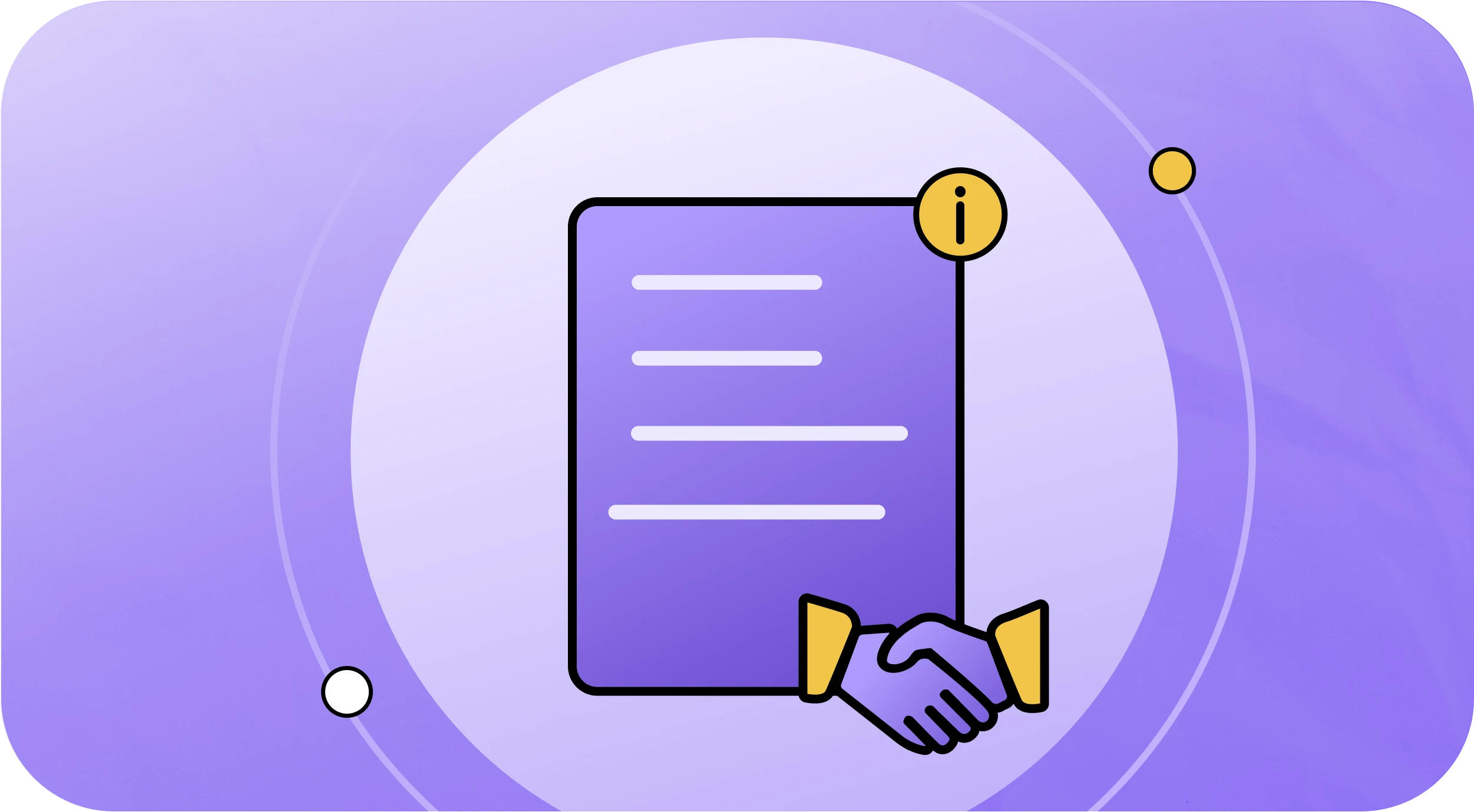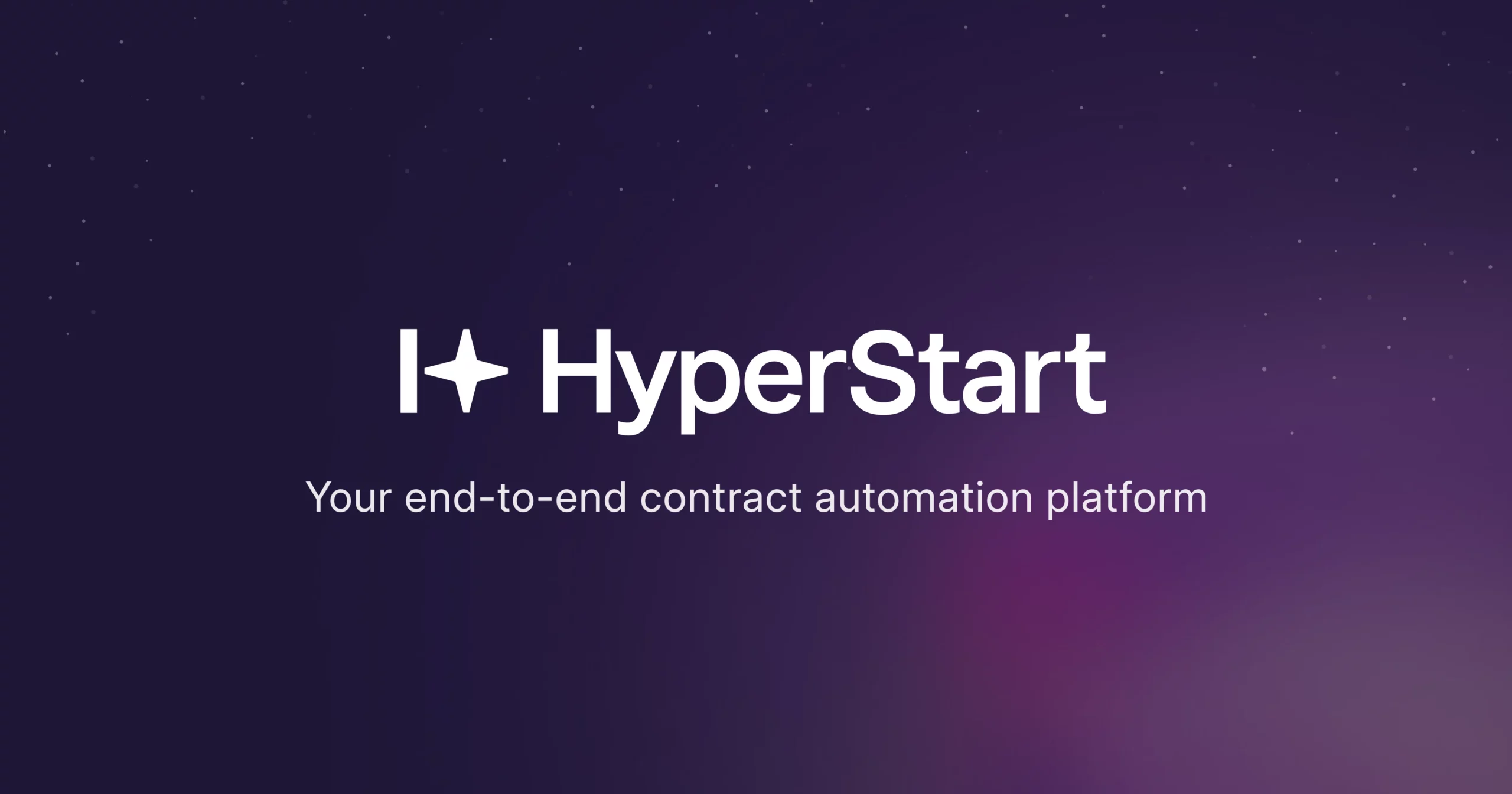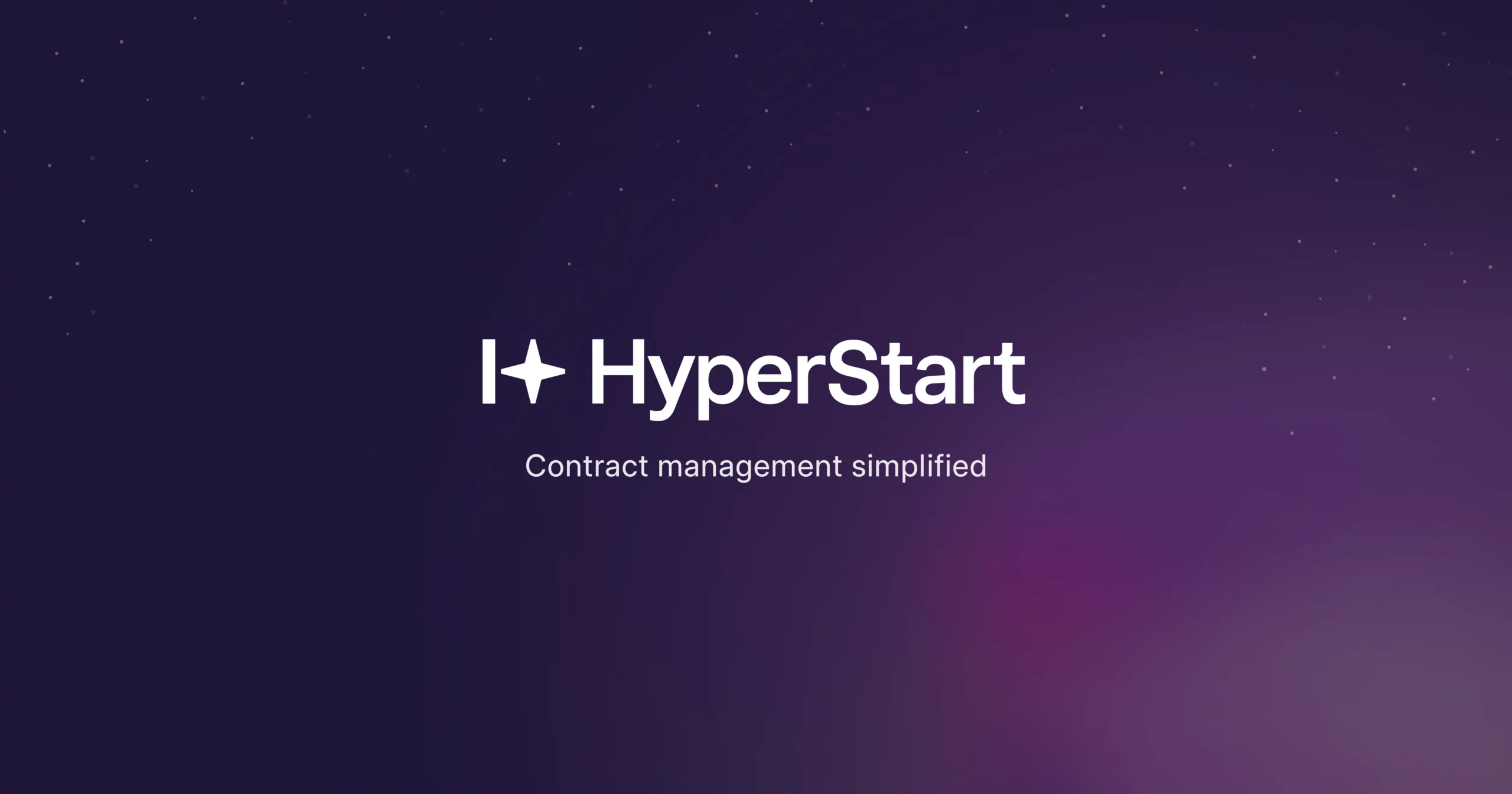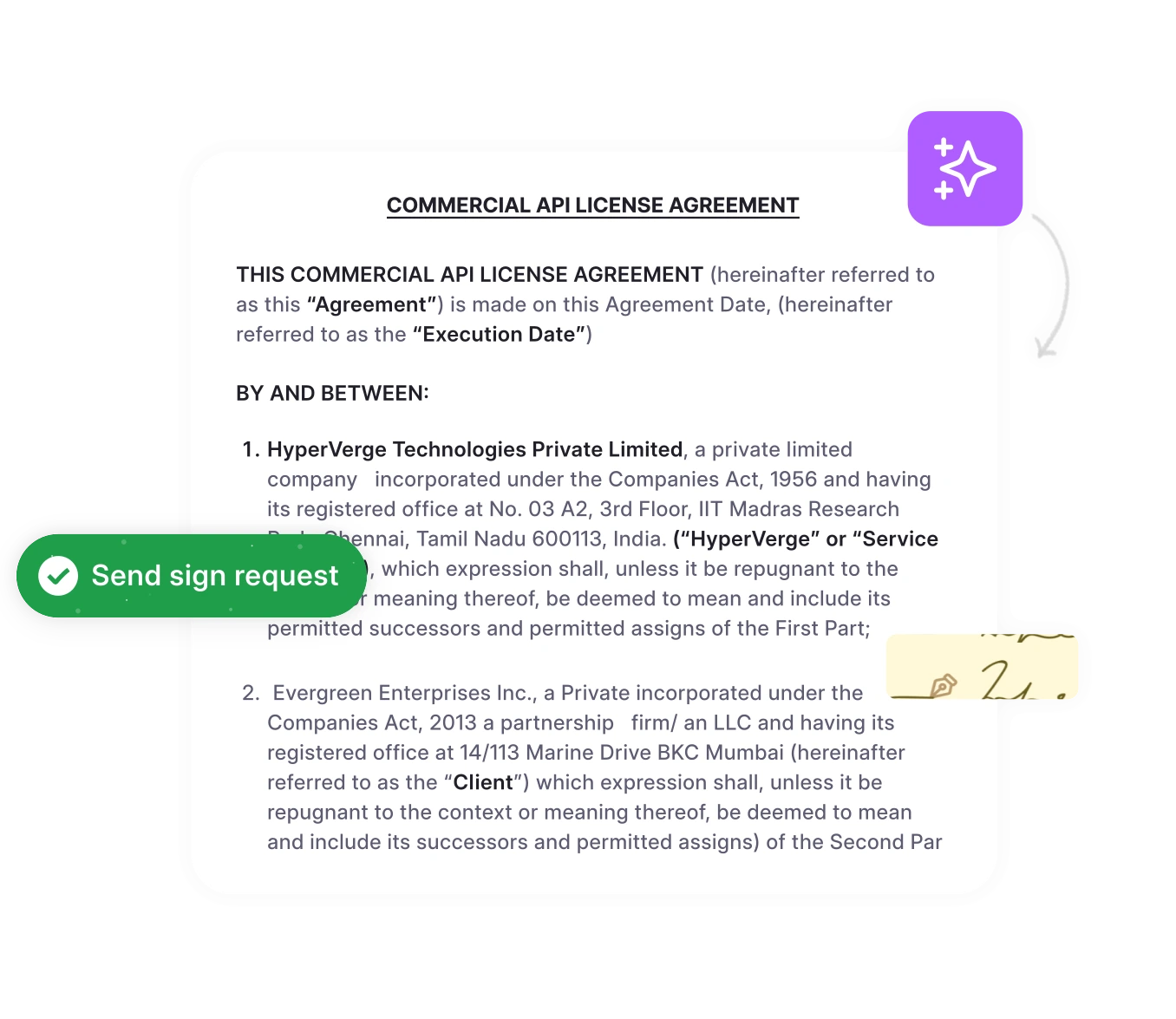Legal teams handle various types of NDA every week — from employee agreements to business partnerships. But choosing the wrong type of non-disclosure agreement (NDA) can cause legal issues and delay important deals.
If you’ve ever wondered “what is an NDA form” or “what does NDA stand for in business,” this guide breaks it all down. You’ll learn what an NDA means in business, explore common NDA types, and understand how AI simplifies managing these agreements at scale.
This guide explains the various types of NDA agreements, including unilateral, bilateral, and multilateral options. You’ll learn when to use each type, see real-world examples, and discover how to manage them efficiently. Whether you work with simple non-disclosure agreements or complex multi-party deals, knowing these differences helps turn contract chaos into organized operations.
HyperStart’s AI reads thousands of types of NDAs with accuracy. The system automatically sorts and routes agreements based on their contract type and complexity. Transform your NDA chaos with AI-powered contract management that grows with your legal team.
What is a non-disclosure agreement?
What is a non-disclosure agreement? An NDA is a legal contract that protects confidential information from being disclosed to unauthorized individuals. When you sign an NDA, you promise to keep specific information secret and face legal consequences if you break that promise.
How much does an NDA cost? While free NDA templates exist online, a professionally drafted NDA can cost anywhere between $100–$1,000, depending on complexity, parties involved, and legal customization needs. Using an AI-powered platform like HyperStart can significantly reduce these drafting and review costs.
NDA meaning in business is straightforward: these agreements create legal frameworks that allow companies to share sensitive information safely.
What are NDAs used for? Companies use them during employee onboarding, investor discussions, partnerships, vendor relationships, and merger negotiations.
Ready to eliminate manual tracking?
Modern contract lifecycle management platforms automate NDA workflows from creation to compliance monitoring across all agreement types.
Book a DemoWhat are the three primary types of NDAs?
What are the three types of NDA? Understanding the differences between these agreement structures helps you choose the right protection for each business situation.
| NDA Type | Parties Involved | Information Flow | Best Used For |
| Unilateral NDA | Two parties | One-way (only one party shares) | Employee onboarding, contractor work, vendor relationships |
| Bilateral NDA | Two parties | Two-way (both parties share) | Business partnerships, merger discussions, joint ventures |
| Multilateral NDA | Three or more | Multiple directions | Consortium projects, complex deals, multi-party collaborations |
Each type of NDA serves different business needs and offers varying levels of protection. A unilateral NDA works when only your company shares confidential information. A bilateral non-disclosure agreement provides mutual protection when both parties exchange sensitive data. Multilateral NDAs handle complex situations involving multiple organizations.
Now, let’s dive deeper into each of these types of NDAs in detail, starting with the most commonly used option.
Unilateral NDAs
A unilateral NDA is a one-way confidentiality agreement where only one party shares confidential information. Also called a one-way NDA or one-way non-disclosure agreement, this unilateral contract type protects the disclosing party while placing obligations only on the receiving party. The unilateral NDA meaning centers on asymmetric information sharing, where your company reveals sensitive data but receives none in return.
In unilateral agreements, information flows in a single direction. Your company holds all the confidential information, while the other party signs away their right to share what they learn. This makes unilateral NDAs the simplest and most common type of confidentiality agreement in business relationships.
How do unilateral NDAs work?
Unilateral NDAs create a clear legal framework with defined roles and responsibilities. The disclosing party owns and controls all confidential information throughout the duration of the relationship. They decide what information is shared, when it is shared, and how the receiving party can use that information.
The receiving party accepts specific legal contract obligations under the terms of the agreement. They must keep all shared information confidential, use it only for authorized purposes, and return or destroy materials upon contract termination of the relationship. The receiving party cannot share information with third parties without explicit written permission from the disclosing party.
Legal enforceability depends on clear definitions and reasonable terms. Courts typically uphold unilateral NDAs when they specify what constitutes confidential information, outline permitted uses, and include reasonable time limits. The agreement must protect legitimate business interests without being overly broad or restrictive.
3 common mistakes to avoid with unilateral NDAs
Vague confidentiality definitions
Many unilateral NDAs fail because they don’t clearly define what information constitutes confidential information. Using broad phrases like “all business information” or “proprietary data” creates enforcement problems and legal challenges.
Solution: Specify confidential information categories explicitly, such as customer lists, pricing data, technical specifications, and business processes. Include both written and oral information in your definitions.
Missing return provisions
Companies often overlook including clauses that require the return or destruction of confidential materials upon the termination of the relationship. This oversight leaves sensitive information in unauthorized hands indefinitely.
Solution: Include precise requirements for returning physical documents, deleting digital files, and destroying copies within a specified timeframe after the relationship concludes.
Overly broad scope
Some unilateral NDAs attempt to cover every possible piece of information, making them legally unenforceable. Courts reject agreements that are too restrictive or prevent normal business operations.
Solution: Limit confidentiality obligations to genuinely sensitive business information. Exclude publicly available data, independently developed information, and knowledge the receiving party already possesses.
3 best practices for unilateral NDAs
Implement standardized review workflows
Create consistent processes for evaluating when an NDA for contractors, employees, or vendors makes business sense. Develop internal checklists that help teams answer the question ‘when do you need an NDA?’ versus when simpler protections suffice.
Benefit: Standardized workflows prevent both over-protection and under-protection of business information while ensuring legal compliance across all departments.
Establish clear approval hierarchies
Establish contract approval processes that align with the complexity of NDAs and assign the appropriate decision-making authority. Simple contractor NDAs require only department manager approval, while complex vendor relationships necessitate a legal review.
Benefit: Proper approval hierarchies facilitate efficient business relationships while ensuring appropriate legal oversight and risk management.
Use technology for tracking and monitoring
Deploy contract management systems that automatically track NDA expiration dates, renewal requirements, and compliance obligations. Monitor which parties have access to specific types of confidential information.
Benefit: Technology-driven tracking prevents information leaks, ensures timely contract renewals, and provides audit trails for compliance purposes.
Bilateral NDAs
A bilateral NDA is a two-way confidentiality agreement where both parties share and protect each other’s confidential information. Also known as a bilateral non-disclosure agreement, mutual NDA, or two-way NDA, this contract type creates reciprocal obligations for all parties involved. Understanding the differences between mutual NDA and unilateral NDA helps you choose the right protection level for your business relationships.
In bilateral agreements, information flows in multiple directions. Both companies reveal sensitive data while accepting equal obligations to protect what they receive. This balanced approach is effective when partnerships require shared knowledge, joint development, or collaborative decision-making among organizations.
How do bilateral NDAs work?
Bilateral NDAs establish mutual responsibilities and equal protection for all parties involved. Each organization becomes both a disclosing party and a receiving party under the same agreement. This dual role creates balanced obligations where everyone shares similar risks and benefits from the confidentiality arrangement.
Correctly identifying the parties is the first step. In any contract or legally binding document, it’s essential to identify the parties interested in the transaction clearly.
Read
Both parties must implement identical protection measures for received information. They cannot share confidential data with third parties, must use information only for authorized purposes, and need written permission before disclosing details to external organizations. The agreement applies equally regardless of which party originally shared specific information.
Legal enforcement becomes more complex with bilateral arrangements. Courts evaluate whether both parties received adequate protection and whether obligations remain fair and reasonable for all involved organizations. The agreement must clearly identify each party’s confidential information and establish consistent standards for protecting that information.
3 common mistakes to avoid with bilateral NDAs
Unequal protection terms
Many bilateral NDAs inadvertently favor one party over another by including different protection levels, time periods, or enforcement mechanisms. These imbalances create legal vulnerabilities and potential disputes.
Solution: Use identical language for all parties’ obligations. Apply the same confidentiality definitions, protection requirements, and time limits to every organization involved in the agreement.
Inadequate information categorization
Bilateral NDAs often fail to distinguish between each party’s confidential information clearly. This confusion leads to disputes about what information belongs to whom and what protection levels apply.
Solution: Create separate schedules or appendices that explicitly list each party’s confidential information categories. Use precise marking requirements to identify ownership during information exchanges.
Missing dispute resolution mechanisms
Complex bilateral relationships can give rise to disagreements over confidentiality breaches, information ownership, or authorized uses of information. NDAs without transparent dispute resolution processes lead to expensive litigation.
Solution: Include structured dispute resolution clauses that specify mediation requirements, arbitration procedures, and governing law. Define escalation processes for handling confidentiality disputes.
3 best practices for bilateral NDAs
Create balanced negotiation processes
Develop fair contract negotiation strategies that ensure all parties receive adequate protection without favoring any single organization. Use standard confidentiality agreement templates as starting points for discussions.
Benefit: Balanced negotiations build stronger business relationships and reduce the likelihood of future disputes or enforcement challenges.
Implement cross-party compliance monitoring
Establish systems that track how all parties handle shared confidential information. Conduct regular check-ins and compliance reviews to ensure that everyone meets their obligations under the bilateral agreement.
Benefit: Proactive monitoring prevents confidentiality breaches and demonstrates good faith compliance to all parties involved in the relationship.
Design flexible information sharing protocols
Develop structured processes for sharing confidential information that adapt to changing business needs and evolving relationships. Build in approval mechanisms for expanding or restricting information access as partnerships develop.
Benefit: Flexible protocols support dynamic business relationships while maintaining appropriate confidentiality protections as collaborations evolve.
Multilateral NDAs
A multilateral NDA is a confidentiality agreement involving three or more parties where at least one organization shares confidential information with multiple recipients. Also known as a 3-way NDA, these agreements manage complex information-sharing scenarios that simple bilateral contracts cannot handle effectively when exactly three parties participate.
Multilateral arrangements create intricate information flow patterns. Some parties may only receive information, while others both share and receive confidential data. The agreement must clearly specify each organization’s role, responsibilities, and access levels throughout the collaborative relationship.
How do multilateral NDAs work?
Multilateral NDAs establish complex legal frameworks with clearly defined roles for each participating organization. Some parties serve as primary disclosing entities that own and control the majority of confidential information. Other parties function as receiving entities with limited sharing obligations but extensive protection responsibilities.
Information access levels vary significantly among parties in multilateral arrangements. Primary disclosers typically receive the broadest access to shared information, while secondary participants may only access specific data categories relevant to their role. The agreement must specify exactly what information each party can access and how they can use it.
Legal complexity increases exponentially with the addition of each new party. The agreement must address potential conflicts between parties, define enforcement mechanisms that work for all organizations, and establish clear procedures for handling breaches or disputes. Each party’s obligations must remain enforceable regardless of what other parties do or fail to do.
3 common mistakes to avoid with multilateral NDAs
Unclear party roles and responsibilities
Multilateral NDAs often fail to clearly define each organization’s specific role, access levels, and obligations. This ambiguity creates confusion about who can share what information and with whom.
Solution: Create detailed party schedules that specify each organization’s role as discloser, recipient, or both. Define exact information categories that each party can access and their permitted uses.
Inadequate breach notification procedures
Complex multilateral relationships make it difficult to track confidentiality breaches and notify affected parties promptly. Delays in breach notification can compound damages and complicate legal responses.
Solution: Establish clear breach notification timelines and procedures. Require immediate notification to all affected parties and specify escalation processes for serious violations.
Overly complex enforcement mechanisms
Some multilateral NDAs create enforcement procedures so complex that parties cannot realistically pursue remedies for confidentiality breaches. These mechanisms become effectively useless in practice.
Solution: Design streamlined enforcement procedures that allow rapid response to breaches. Include clear remedy options and specify which parties can pursue enforcement actions.
3 best practices for multilateral NDAs
1. Establish clear information governance structures
Create detailed frameworks that specify how confidential information flows between parties, who controls access decisions, and how changes to access levels get approved throughout the relationship.
Benefit: Clear governance prevents unauthorized information sharing and ensures all parties understand their roles in protecting shared confidential data.
2. Implement centralized compliance monitoring
Designate a lead organization or neutral third party to monitor compliance across all parties. Establish regular reporting requirements and audit procedures to ensure that everyone meets their multilateral obligations.
Benefit: Centralized monitoring provides consistent oversight and early detection of potential compliance issues, allowing for prompt resolution before they escalate into serious breaches.
3. Design scalable agreement structures
Develop multilateral NDAs that can accommodate the addition of new parties or the departure of existing parties from the arrangement. Include procedures for modifying party roles and information access as relationships evolve.
Benefit: Scalable structures support dynamic business collaborations while maintaining appropriate confidentiality protections as partnerships change over time.
Ready to eliminate manual tracking?
Modern contract lifecycle management platforms automate NDA workflows from creation to compliance monitoring across all agreement types.
Book a DemoHow do different industries approach NDA types?
Industry requirements significantly impact which types of NDAs are most effective for specific business scenarios. Regulatory compliance, data sensitivity levels, and operational complexity determine whether organizations need simple unilateral agreements or complex multilateral structures.
Boilerplate NDA templates often fail to meet the needs of all industries, as sector-specific requirements necessitate customized approaches. Healthcare organizations face HIPAA compliance requirements that differ from those applicable to manufacturing companies. Financial services firms face regulatory oversight that technology startups typically don’t encounter.
| Industry | Preferred NDA Type | Key Considerations | Compliance Requirements |
| Technology | Bilateral | IP protection, source code sharing, joint development | SOC 2, data privacy laws |
| Healthcare | Unilateral | Patient data protection, research confidentiality | HIPAA, FDA regulations |
| Financial Services | Bilateral | Client data, regulatory reporting, risk assessment | SOX, banking regulations |
| Manufacturing | Unilateral | Trade secrets, supplier relationships, process documentation | Industry safety standards |
| Legal Services | Unilateral | Attorney-client privilege, case information, client confidentiality | Bar association rules |
| Pharmaceuticals | Multilateral | Research collaboration, clinical trial data, and drug development | FDA, international regulations |
The purpose of NDA examples varies dramatically by industry context. Technology companies use bilateral NDAs for partnership discussions and joint development projects. Healthcare organizations rely heavily on unilateral agreements to protect patient information and research data. Manufacturing firms need supplier NDAs that protect proprietary processes and trade secrets.
Legal services firms face unique challenges because they already operate under the protections of the attorney-client privilege. Their NDAs often focus on business operations rather than legal work. Financial services companies must balance client confidentiality with regulatory reporting requirements, creating complex NDA structures.
Smart organizations tailor their NDA types to industry-specific risks and regulatory requirements, rather than relying on generic templates that may not provide adequate protection.
How to manage different types of NDA efficiently?
Managing multiple NDA types efficiently requires a systematic approach that handles volume, complexity, and compliance requirements simultaneously. Legal teams processing hundreds of confidentiality agreements need automated systems that classify, route, and track different agreement types without manual intervention.
5 strategies for efficient NDA management
1. Implement automated classification systems
Use AI-powered platforms that automatically identify types of NDAs based on party structure, information flow, and key terms. AI contract review technology can instantly categorize unilateral, bilateral, and multilateral agreements while flagging unusual terms that need human attention.
2. Create standardized template libraries
Develop comprehensive standardized contracts for each NDA type and industry application. Organize templates by complexity level, party structure, and specific use cases to expedite agreement creation and minimize legal review time.
3. Deploy intelligent workflow automation
Set up contract management automation that routes different NDA types to appropriate reviewers based on complexity, value, and risk levels. Simple unilateral NDAs can follow expedited approval paths while complex multilateral agreements get a comprehensive legal review.
4. Use contract intelligence for tracking
Implement contract intelligence systems that extract metadata from all types of NDAs and create searchable databases. Track expiration dates, renewal requirements, and compliance obligations across your entire NDA portfolio automatically.
5. Enable rapid contract authoring
Provide business teams with contract authoring tools that generate appropriate NDA types based on business scenarios. Sales teams can create vendor NDAs instantly while partnership teams access bilateral agreement templates for joint ventures.
HyperStart’s AI processes thousands of NDA types with 99% accuracy, automatically classifying agreements and routing them through appropriate workflows. The system reduces NDA processing time by 80% while ensuring consistent compliance across all agreement types.
Effective NDAs consider governing law, state ownership, define confidential information, set operational requirements, and provide context.
Read
How HyperStart streamlines different types of NDA
Understanding types of NDA agreements transforms legal operations from reactive chaos to proactive efficiency. With HyperStart, you get more than just visibility—you get automation, accuracy, and speed.
Whether you need unilateral NDAs for employee protection, bilateral NDAs for partnerships, or multilateral NDAs for complex collaborations, HyperStart ensures the right NDA type is applied, reducing legal risks and operational delays.
Smart legal teams using HyperStart don’t just track NDAs—they automate classification, routing, and compliance monitoring across all agreements. Manual bottlenecks that slow deals are eliminated.HyperStart – AI-powered contract management system processes thousands of NDAs with speed and precision, instantly classifying agreement types and routing them through optimized workflows so your legal team can focus on strategic work instead of repetitive tasks.











